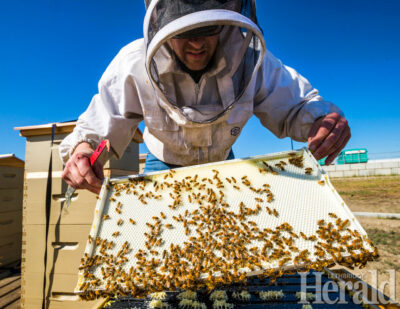SACPA abuzz with the important role of bees
By Justin Seward - Lethbridge Herald on April 20, 2022.
 Robert McBain, of Worker and Hive Bee Supply, checks honey combs from inside one of the hives set up in 2019 at the City's Waste and Recycling Centre. Herald file photo by Ian Martens
Robert McBain, of Worker and Hive Bee Supply, checks honey combs from inside one of the hives set up in 2019 at the City's Waste and Recycling Centre. Herald file photo by Ian MartensSouthern Alberta Council on Public Affairs had Shelley Hoover tune into their virtual meeting on Thursday to talk about issued that that are affecting bees, how they can be helped and what role they play in Alberta.
Hoover studies apiculture and pollination in the department of Biological Sciences at University of Lethbridge.
Her research is tailored to bee health and management, breeding and nutrition, canola pollination and the effects of environmental change on plant pollinator interactions.
Hoover began her presentation by chatting about simply what is a bee.
“We think we know, but there’s a lot of things in our bees that we don’t think off and a lot of things that we might think of our bees that are in fact not,” said Hoover.
There have been 16,000 bee species identified globally and Hoover anticipated that number could be even higher as those types are just what researchers have names for.
“Some of them are what we typically think of that are stripy, yellow and black but some are not,” said Hoover.
Bees can be iridescent, jewel-toned, green, rainbowed, blue, red, black, small and large, says Hoover.
“The main thing they have in common through visibly is that they’re all really hairy,” she said.
“If you look at the picture of the big black face on this slide, you’ll see a tiny little bee called Perdita minima that’s smaller than the eyeball of the other bee that it’s on. So, these are really tiny creatures – some of them you might not even notice they’re in your yard.”
There are about 750 known species of bees in Canada, with over 40 per cent in Alberta.
“And especially in southern Alberta, we’re in a bit of a bee biodiversity hot spot, where we have almost 100 species in Canada that are found only in southern Alberta,” said Hoover.
“And a lot these occur between Lethbridge and Medicine Hat and that’s in part because that’s where a lot of people have looked for these animals.”
People tend to care for them because of the food on their plate.
“Animal pollinators enhance the seed set of three-quarters of all of our food crops,” said Hoover.
She gave the example of being a garden where bees would be more important in carrot seed production rather than in carrot production on its own.
“But you do need a bee to pollinate the flower that produces the seed that you plant,” she said.
A most recent development in honey beekeeping has been with the advents with newer crops, especially with the canola crop.
“With these hybrid varieties that have been developed, we see an increase in the call for pollination and that’s driven an increase in the number of colonies here in southern Alberta,” said Hoover.
Alberta has close to 300,000 beekeeping colonies.
Stressors that affect a bee’s health include nutrition, what are the flowers on the landscape, what are humans doing to the landscape in terms of building cities and changing habitats and climate change.
“For honeybees, specifically, there’s issues with Queen failure,” she said.
“We see that some of these imported Queens that don’t do necessarily that well. And then of course pesticides, fungicides, herbicides – all of these things that we’re putting out into the environment have impacts on bees – as well as diseases and parasites. I mentioned foulbrood, which is a mite that sucks the hemolymph or fat bodies out of honeybees specifically and that is a major problem for honeybee keepers.”
Whether it’s honey or native bees, people can help out the population by planting flowers – especially trees and shrubs – where a lot of flowers can be produced per square foot and are perennials.
-1




